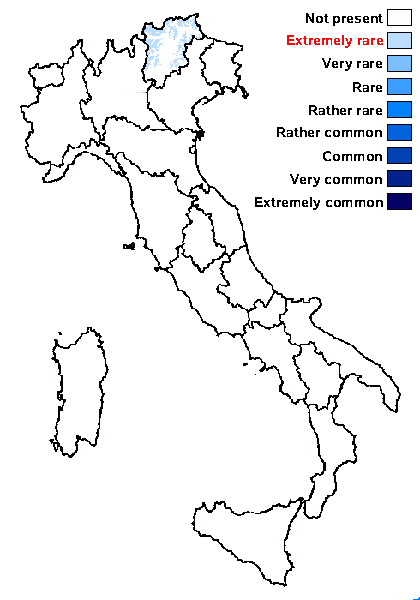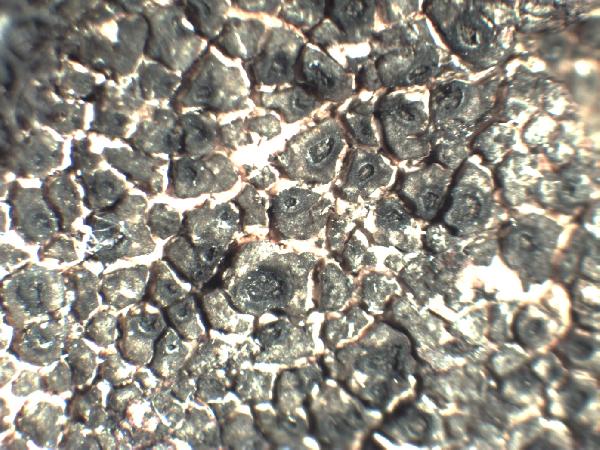Aspicilia fluviatilis A. Nordin & Owe-Larss.
Lichenologist, 43: 30, 2011.
Synonyms: Aspicilia cinerea f. alpina Arnold ?
Distribution: N - TAA (Szczepańska & al. 2024).
Description: Thallus crustose-placodioid, episubstratic, cream-coloured, pale grey or ochraceous grey, partly with a brownish tinge, 0.2-0.5 mm thick, the inner part irregularly cracked-areolate, in outer part forming a dendroid branching pattern, the areoles smooth, flat to slightly convex, angular and 0.2-0.4 mm wide in central parts, elongated, radiating, branched and 0.5-1 mm long in marginal parts. Cortex paraplectenchymatous, obscured by norstictic acid crystals, c. 22-43 μm. thick, the cells c. 5-9 μm wide; epinecral layer up to 8 μm thick; medulla white, with abundant Ca-oxalate crystals; hypothallus absent or dark brown to black, visible between the areoles in the inner part of the thallus, sometimes also in the marginal zone. Apothecia lecanorine-aspicilioid, immersed to broadly attached, round to irregular, sometimes confluent, 0.2-0.7 mm across, 1-2(-4) per areole, with a dark brown to black, at first smooth but soon uneven, concave to slightly convex, sometimes grey-white pruinose (norstictic acid) disc, the thalline margin blackening in older apothecia, usually with a white inner rim. Proper exciple c. 40-55 μm thick in upper part, narrowing below; epithecium brown-green (Caesiocinerea-green), N+ green, K+ red-brown; hymenium colourless, 50-100 μm high; paraphyses branched and anastomosing, the apical cells mainly moniliform, subglobose, up to 3.5 μm wide; hypothecium colourless, 40-90 μm high. Asci 8-spored, clavate, the thin outer coat K/I+ blue, the wall and apical dome K/I-. Ascospores 1-celled, hyaline, broadly ellipsoid, 15-25(-28) x (5-)7-13(-16) μm. Pycnidia rare, the wall pigmented in upper part only. Conidia thread-like, 11-17 x c. 1 μm. Photobiont chlorococcoid. Spot tests: thallus and sometimes apothecial disc (pruina) K+ yellow turning red (needle-like crystals), C-, KC-, P+ yellow orange. Chemistry: norstictic acid in cortex and in the pruina of the apothecia; Caesiocinerea-green pigment in the epithecium.Note: a rare silicicolous species growing close to running water or on humid scree slopes, known from the mountains of Siberia and Scandinavia, and recently found also in the Czech Republic (Tatra Mtns.) and the Italian Alps (Paneveggio-Pale di San Martino). For further details see the original description and Szczepańska & al. (2024).
Growth form: Crustose placodiomorph
Substrata: rocks
Photobiont: green algae other than Trentepohlia
Reproductive strategy: mainly sexual
Commonnes-rarity: (info)
Alpine belt: extremely rare
Subalpine belt: absent
Oromediterranean belt: absent
Montane belt: absent
Submediterranean belt: absent
Padanian area: absent
Humid submediterranean belt: absent
Humid mediterranean belt: absent
Dry mediterranean belt: absent

Predictive model
Growth form: Crustose placodiomorph
Substrata: rocks
Photobiont: green algae other than Trentepohlia
Reproductive strategy: mainly sexual
Commonnes-rarity: (info)
Alpine belt: extremely rare
Subalpine belt: absent
Oromediterranean belt: absent
Montane belt: absent
Submediterranean belt: absent
Padanian area: absent
Humid submediterranean belt: absent
Humid mediterranean belt: absent
Dry mediterranean belt: absent

Predictive model
 DOLICHENS
DOLICHENS


